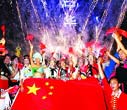News
A timeline of China's macro-economic policy shifts
(Xinhua)
Updated: 2008-11-09 20:23
China will adopt an "active" fiscal policy and a "moderately easy" monetary policy to boost its economy, according to an executive meeting of the State Council, or cabinet, on Sunday.
These stances mark a shift from "prudent" fiscal and "tight" monetary policies the government adopted at the start of 2008. And they are one of only a few major policy shifts in the past three decades.
Before Sunday, China had made six major macro-economic policy shifts over the 30 years since the era of reform and opening up began in 1978:
-- From 1979 to 1981, China moved to cool an overheated economy and inflation resulting from investment booms since 1978. The government lowered economic targets, curtailed spending, tightened credit controls and froze corporate savings through administrative means.
-- From 1985 to 1986, China adopted tight fiscal and monetary policies after economic growth surged 15.2 percent in 1984 on strong investment. It was the first time the government tried to use fiscal and monetary policies in macro-controls, which included curbing bank lending and money supply.
-- From 1989 to 1990, runaway price rises and heady investment growth led to a series of strong actions by the government, which imposed price caps on major industrial inputs, reduced expenditure, strictly controlled credit and at one point even halted lending to township enterprises. As a result, economic growth plummeted to 3.8 percent in 1990 from 11.3 percent in 1988.
-- From 1991 to 1997, China pursued "appropriately tight" fiscal and monetary policies. It reduced interest rates and expanded money supply at first to revive the economy, but saw a record high inflation rate of 21.7 percent in 1994. The government managed to curb price hikes by keeping the growth of money supply and fiscal outlays within a moderate range.
-- From 1998 to 2003, China turned to an "active" fiscal and "prudent" monetary policy after the Asian financial crisis dragged down the economy and added deflation risks. Government spending was hiked and more debt was issued to fund infrastructure projects. Measures were taken to increase revenues of low-income groups and improve social welfare to stimulate domestic demand.
While reducing interest rates, the government started to tax interest on deposits and adjusted money supply through central bank open-market operations.
-- From 2004 to 2008, with excessive credit and fixed-asset investment growth and strained supplies of energy and grain, China embarked on a new phase of macro-controls to prevent overheating and inflation. During that period, it modified its stances several times without a fundamental overall change.
The government changed its fiscal policy from "active" to "prudent" in 2005. It continued to pursue a prudent monetary policy till June 2007, when the cabinet proposed a "prudent" but "appropriately tight" monetary policy to counter rising inflationary pressure.
In December 2007, the government decided to adopt a "tight" monetary policy and continue the "prudent" fiscal policy in 2008.







